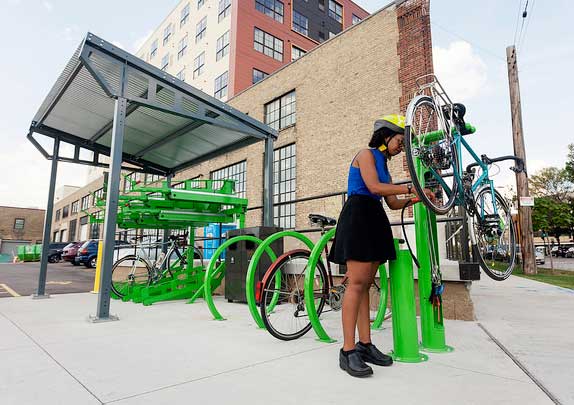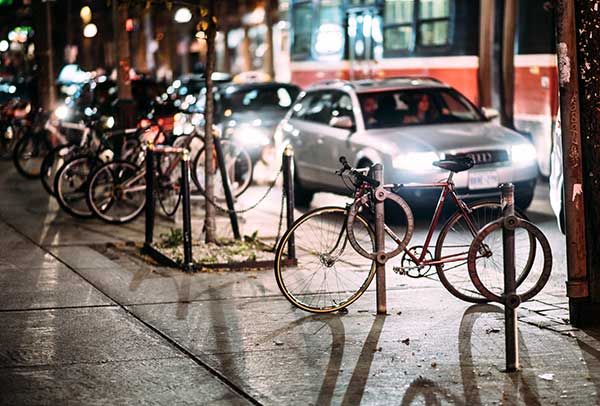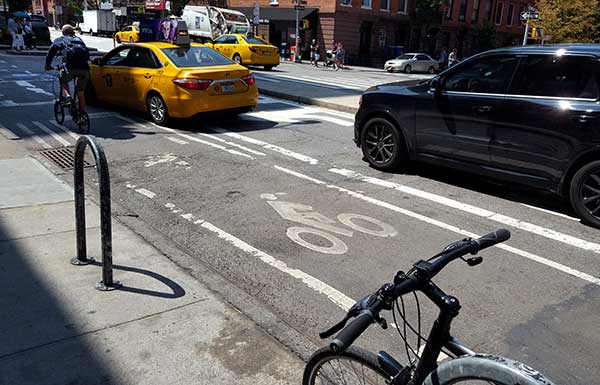 How well does your state rank for investing in bicycle infrastructure? Pictured above are a bike shelter, bike repair station, tiered bike racks and outdoor bike racks
How well does your state rank for investing in bicycle infrastructure? Pictured above are a bike shelter, bike repair station, tiered bike racks and outdoor bike racks
Does your state care about bicyclists? What are your state and city officials doing to make streets safer for bicyclists? What are other states investing to make life better for bicyclists and how does your state compare to them?
Bicycling today is bigger than ever. According to Statista, there were 66.5 million cyclists in the US in 2016. That means 12.4% of Americans ride a bicycle on a regular basis. That's a lot of bicycles on the road. Millions. Bike sales are booming. The Millennial generation even prefers bikes over cars.
So what is your state doing to accommodate this trend?
Fortunately, there is a group monitoring state progress - The League of American Bicyclists.
They issue a report card on what each state is doing for the benefit of bicycle riders.
Changing the bicycling infrastructure in any state starts with bicycle advocacy groups. These are the dedicated people who push legislators on the state level and city council members on the local level to care more about bicycles. They are the people who present the case on why it's important to allocate funds for safe streets so people can safely ride from Point A to Point B without getting hurt or even killed.
Which groups are advocating for bicyclists in your particular state? Check the League of American Bicyclists advocacy page to see the state organizations that have registered with the League and are recognized as legitimate groups working on these projects.
Then join them.
How the League ranks states
The League of American Bicyclists uses these six criteria to judge the bicycle friendliness of each state.
Those factors include:
- Infrastructure and Funding - this criteria covers how much your state spends on bicycle infrastructure such as bike lanes, bicycle parking racks or complete streets. What sort of grants do they provide for local towns and cities to make bicycling safer?
- Education and Encouragement - this covers public education on bicycle safety and involves a survey sent to the department of transportation for each state to determine the administration's understanding of the need for bicycle infrastructure and their commitment to fund it.
- Legislation and Enforcement - it's important that each state adopt laws that protect bicyclists, such as motorists giving bicycle riders at least three feet of space when passing. Surprisingly, not every state has enacted some of these simple safety measures.
- Policies and Programs - this covers the policies and programs involved in projects conducted by state departments of transportation. Does this state actually include bicycles in their policy decisions? Are they actively working on extending bicycle networks rather than still evaluating the value of bicycles in the overall transportation framework?
- Evaluation and Planning - what are the actual plans for bicycle safety? Does the state collect data on bicycle transportation and bicycle safety?
- Discretionary Scoring - other developments in the state for bicycles are thrown into this category for consideration.
 Bollard bike racks provide bicycle parking on a busy city street
Bollard bike racks provide bicycle parking on a busy city street
Ranking of top 20 most bicycle-friendly states
Here's the top 20 list of the most Bicycle-Friendly States from the League of American Bicyclists.
- Washington
- Minnesota
- California
- Massachusetts
- Oregon
- Colorado
- Delaware
- Utah
- New Jersey
- Virgina
- Maryland
- Pennsylvania
- Michigan
- Vermont
- Florida
- Illinois
- Maine
- Ohio
- Georgia
- North Carolina
It's not difficult to see why some states far outrank others in terms of being bicycle friendly.
Take Washington State for example.
The state's department of transportation has created a new Active Transportation Division which says that bicycling (and walking) are now just as important as other modes of transportation such as cars, trains, and buses.
This is the first state agency to make this commitment in the entire US. The agency backs up this commitment with a pledge to allocate $20 million per year over the next 16 years for bicycling and walking projects.
For the five major criteria, this is how Washington ranks: Infrastructure and Funding - 2; Education and Encouragement - 7; Legislation and Enforcement - 3; Policies and Programs - 2 and Evaluation and Planning - 4.
The state has a Complete Streets Policy, implemented a Statewide Bike Plan for the last 10 years, spends 2% or more of federal funds on bike and pedestrian projects and excels in bicycle safety programs.
Another factor that indicates the level of bicycle concern is the number of bike-friendly entities within a state.
Washington State has 18 communities that are designated as bicycle friendly by the League with 46 bicycle-friendly designated businesses and one bicycle friendly university.
As most people can see, the criteria for ranking is not that difficult to achieve. Any state that allocates funds for bicycle infrastructure and commits state resources to promote bicycle safety and the use of bicycles as an alternative mode of transportation could easily move up in rankings.
Start on the local level. It's not that difficult to receive a designation as bicycle-friendly. It costs nothing for a city to apply and there are currently more than 400 communities on the list. In addition, think of the marketing potential for any town to tout themselves as a Bicycle-Friendly Community. That will certainly attract the attention of bicyclists who might want to move or work there or visit as tourists.
Same goes for Bicycle-Friendly Businesses. There is a fee for this application but the promotional aspects offer a great return on investment as far as showing that a business is bicycle minded. This designation appeals to employees, future hires, customers and the surrounding community where the business is located.
For universities and colleges in the state, there is a flat fee to apply, but again, the appeal to students would be immense. There are currently 164 Bicycle-Friendly Universities in the country.
 Bike lane in New York City. The League of American Bicyclists ranks states on how well they invest in making streets safe for bicyclists
Bike lane in New York City. The League of American Bicyclists ranks states on how well they invest in making streets safe for bicyclists
How to find bike advocacy groups in your state
As we said, all these changes to promote bicycling infrastructure and safety have to be advanced by some group of passionate cyclists. There are quite a few entities out there all competing for federal, state and local dollars.
If you go to the League of America Bicyclists' website, you can see a list of recognized bike advocacy groups in your state.
For example, in Washington State there are these groups:
- 3 Rivers Bicycle Coalition - Richland, WA
- Puyallup Watershed Initiative Active Transportation Community - Tacoma, WA
- Wheelhouse Community Bike Shop - Kennewick, WA
- Cascade Bicycle Club - Seattle, WA
- Whidbey Island Bicycle Club - Coupeville, WA
- Bike Works Seattle - Seattle, WA
- Squeaky Wheels (now that's the perfect name to promote change) - Bainbridge Island, WA
The page also lists the bicycle-friendly communities, businesses and universities plus bike shops, cycling instructors and supporting businesses.
If you don't see an advocacy group in your area, start one.
The League and other advocacy groups in your state would be glad to help you.
That's because persuading state legislators and state departments to make policy changes is a numbers game. The more people, businesses, and universities you have involved in the project, the more likely you will get results.
One great advantage today is that the League of American Bicyclists already provides a ton of supporting research material for any state, city or university to make the case for improving bicycle infrastructure and safety. They have a complete report card listing all the items that need to be addressed.
In addition, they provide a complete profile of what other states are accomplishing. No state wants to rank at the bottom for poor bicycle infrastructure and they certainly don't want to rank at the bottom end for bicycle fatalities and injuries.
Bicycling is big in America today. Every state and city should have officials or departments in their administration committed to helping bicyclists (and pedestrians).
That means building complete streets, adding protected bike lanes, providing bicycle parking racks, enacting and enforcing laws to protect bicyclists and educating the public about bicycles.
Another big movement is in the implementation of bike share programs. Bike sharing provides easy access for local citizens to ride - just walk down the street and pick out a bike.
The payoff for cities will come in the form of less congested streets, less pollution, and a healthier public. That's a great return on investment.
In addition, building a bike lane is certainly less expensive than building a new road, bridge or train stop.
Surveys of local citizens continually show a desire for more bicycle infrastructure. Show your state and city officials how they can meet that demand.
Note: The Park and Facilities Catalog, a national supplier of outdoor bike racks located in Boca Raton, Fla., has been designated as a Bicycle Friendly Business.


